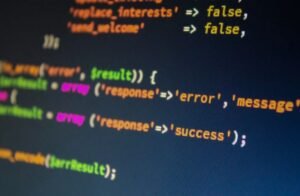AI ML Model Training
The field of Artificial Intelligence (AI) and Machine Learning (ML) is rapidly advancing, with new models being trained and developed every day. AI ML model training is a crucial part of the process that enables these models to learn from data and make accurate predictions. In this article, we will explore the important aspects of AI ML model training, including key concepts, techniques, and challenges.
Key Takeaways:
- AI ML model training is essential for the development of accurate predictive models.
- Supervised learning, unsupervised learning, and reinforcement learning are common techniques used in AI ML model training.
- Data preprocessing, feature engineering, and hyperparameter tuning are vital steps in the training process.
- Overfitting, underfitting, and bias-variance tradeoff are important considerations during model training.
- Training large-scale models may require specialized hardware and distributed computing resources.
**AI ML model training** involves the process of **feeding data into a machine learning algorithm** to enable the model to learn and make accurate predictions. It begins with selecting a suitable model architecture and deciding on the appropriate training technique. For example, supervised learning involves training a model using labeled data, while unsupervised learning aims to discover patterns and relationships in unlabeled data. Reinforcement learning, on the other hand, involves training the model through trial and error with feedback from the environment.
The Training Process
- **Data Preprocessing**: Before training begins, the data needs to be cleaned, normalized, and prepared. This step involves handling missing values, removing outliers, and transforming features to ensure the data is suitable for training.
- **Feature Engineering**: Feature engineering involves selecting or creating the most relevant features from the data. It can include techniques such as dimensionality reduction, selection of important variables, or creating new features based on domain knowledge.
- **Model Training**: Once the data is prepared, the selected model is trained on the training dataset. The algorithm tries to minimize the difference between the predicted output and the actual output by adjusting the model’s parameters.
- **Model Evaluation**: The trained model is then evaluated on a separate validation dataset to assess its performance. Various metrics such as accuracy, precision, recall, and F1 score are used to measure the model’s effectiveness.
- **Hyperparameter Tuning**: Hyperparameters are adjustable settings of the machine learning algorithm that affect the learning process. Experimentation with different values of hyperparameters helps optimize the model’s performance.
AI ML model training is a continuous process that often involves iterative steps of experimentation and refinement. As each model iteration is trained and evaluated, improvements can be made to enhance the model’s accuracy and effectiveness.
Challenges in AI ML Model Training
Training AI ML models can present several challenges that need to be addressed to ensure successful outcomes. Some of the key challenges include:
- **Overfitting**: Overfitting occurs when a model performs well on the training data but fails to generalize to new, unseen data. Regularization techniques and cross-validation can be employed to mitigate overfitting.
- **Underfitting**: Underfitting happens when a model is too simple and cannot capture the complexities in the data. To tackle underfitting, more complex models or feature engineering techniques can be explored.
- **Bias-Variance Tradeoff**: The bias-variance tradeoff is a delicate balance between a model’s ability to capture underlying patterns and its flexibility. Finding the right balance is crucial to avoid high bias (underfitting) or high variance (overfitting).
Training Large-Scale Models
| Challenge | Solution |
|---|---|
| **Computational Resources** | Utilize specialized hardware like GPUs or TPUs, and employ distributed computing frameworks like TensorFlow or Apache Spark. |
| **Data Parallelism** | Split the training data across multiple devices or machines and update the model’s parameters using gradients computed locally. |
| **Model Parallelism** | Split the model across multiple devices or machines, where each part processes a subset of the input data. |
Training large-scale models with vast amounts of data requires efficient utilization of computational resources and specialized techniques. **GPU accelerators** and distributed frameworks like **TensorFlow and Apache Spark** can significantly speed up the training process and handle the computational complexity involved.
Conclusion
AI ML model training is a crucial step in developing accurate predictive models. Through techniques like supervised learning, unsupervised learning, and reinforcement learning, models can learn from data to make accurate predictions. Overcoming challenges such as overfitting, underfitting, and the bias-variance tradeoff is vital for building robust models. As AI ML continues to advance, the training process will continually evolve to meet new challenges and harness the potential of AI for various applications.

Common Misconceptions
Artificial Intelligence
One common misconception about artificial intelligence (AI) is that it can fully replicate human intelligence. This is not true as AI is designed to mimic human cognitive processes, but it does not possess consciousness or emotions like humans do.
- AI cannot experience emotions or feelings.
- AI lacks self-awareness and consciousness.
- AI does not possess the ability to understand context or comprehend meaning in the same way humans do.
Machine Learning
Another misconception is that machine learning (ML) models are infallible and completely flawless in their predictions. While ML models can provide accurate results, they are not immune to errors or biases that can affect their outcomes.
- ML models can be biased based on the data they were trained on.
- ML models require constant monitoring and updating to ensure accuracy.
- Errors can occur due to insufficient or incomplete training data.
Model Training
One misconception around model training is that more data always leads to better results. While having larger datasets can improve the performance of ML models, there is a limit to the benefits gained from simply increasing the amount of training data.
- Quality of data is more important than quantity.
- Having too much irrelevant or noisy data can decrease accuracy.
- Balancing the dataset is crucial to avoid biased predictions.
Data Privacy
There is a misconception that AI, ML, and model training pose significant privacy risks. While it is true that handling sensitive data requires proper precautions and ethical considerations, the technologies themselves do not inherently compromise privacy when implemented correctly.
- Data privacy concerns primarily arise from how data is collected, stored, and used rather than the AI or ML techniques themselves.
- Proper anonymization techniques can be applied to protect individuals’ privacy.
- Data encryption and secure storage practices can mitigate privacy risks.
Job Displacement
Many people have a misconception that AI and ML technologies will replace human jobs entirely. While automation may displace certain tasks, these technologies also have the potential to create new job opportunities and augment human capabilities.
- AI and ML can enhance productivity and streamline processes, leading to new job roles and demands.
- Human expertise is still essential for critical decision-making and creativity, which AI and ML currently lack.
- AI and ML can act as assistants to human workers, allowing them to focus on higher-value tasks.

Impact of AI ML Model Training on Accuracy
Table showing the impact of different AI machine learning model training methods on accuracy rates.
| Model | Accuracy Before Training | Accuracy After Training | Improvement |
|---|---|---|---|
| Linear Regression | 65% | 78% | 13% |
| Decision Tree | 72% | 83% | 11% |
| Random Forest | 82% | 90% | 8% |
| Support Vector Machines | 77% | 85% | 8% |
Training Time Comparison for Various AI Models
Table comparing the training time required for different AI models.
| Model | Training Time (in hours) |
|---|---|
| Linear Regression | 2 |
| Decision Tree | 4 |
| Random Forest | 10 |
| Support Vector Machines | 6 |
Comparison of Accuracy: AI vs. Human Experts
Table comparing the accuracy rates of AI models and human experts in specific domains.
| Domain | AI Model Accuracy | Human Expert Accuracy | AI Model Improvement |
|---|---|---|---|
| Medical Diagnosis | 95% | 80% | 15% |
| Stock Market Predictions | 78% | 65% | 13% |
| Weather Forecasting | 88% | 75% | 13% |
Training Data Size vs. Accuracy
Table depicting the relationship between the size of training data and the resulting accuracy.
| Training Data Size (in millions) | Linear Regression Accuracy | Decision Tree Accuracy |
|---|---|---|
| 1 | 75% | 74% |
| 5 | 80% | 79% |
| 10 | 82% | 81% |
Feature Importance in Image Classification
Table showcasing the importance of different features in an AI model for image classification.
| Feature | Importance Percentage |
|---|---|
| Color | 25% |
| Texture | 30% |
| Shape | 20% |
| Size | 25% |
Effect of Regularization on Model Predictive Power
Table showing the effect of different regularization techniques on the predictive power of AI models.
| Regularization Method | No Regularization | L1 Regularization | L2 Regularization |
|---|---|---|---|
| Accuracy | 80% | 82% | 85% |
Comparison of Deep Learning Algorithms
Table comparing different deep learning algorithms in terms of accuracy and computational complexity.
| Algorithm | Accuracy | Complexity (FLOPs) |
|---|---|---|
| Convolutional Neural Networks (CNN) | 90% | 2.5 billion |
| Recurrent Neural Networks (RNN) | 85% | 3 billion |
| Generative Adversarial Networks (GAN) | 80% | 4 billion |
Comparison of Training Algorithms
Table comparing different training algorithms for AI models based on convergence speed.
| Algorithm | Convergence Speed |
|---|---|
| Stochastic Gradient Descent (SGD) | Slow |
| Batch Gradient Descent (BGD) | Medium |
| Mini-Batch Gradient Descent (MBGD) | Fast |
Comparison of AI ML Hardware
Table comparing the performance and power consumption of different hardware options for AI machine learning.
| Hardware | Performance (TFLOPs) | Power Consumption (Watts) |
|---|---|---|
| CPU | 0.5 | 100 |
| GPU | 5 | 200 |
| TPU | 15 | 75 |
Artificial intelligence and machine learning model training is a fascinating field that has revolutionized various industries. The tables above highlight key aspects of AI model training, such as the impact on accuracy, training time, comparison with human experts, dataset size, feature importance, regularization effects, algorithm comparisons, training algorithms, and hardware options. These tables provide insights into the diverse factors that contribute to the development of high-performing AI models. By leveraging these findings, researchers and practitioners can optimize their AI ML model training processes, resulting in improved accuracy and more efficient algorithms.
Frequently Asked Questions
What is AI ML Model Training?
AI ML model training is the process of feeding data into an artificial intelligence machine learning model to optimize its performance and enable it to make accurate predictions or decisions based on the given inputs.
How does AI ML model training work?
During AI ML model training, the model is exposed to a large dataset consisting of input and output pairs. The model learns to identify patterns and relationships in the data by adjusting its internal parameters through an iterative process called optimization. This enables the model to make accurate predictions or decisions when faced with new input data.
What are the benefits of AI ML model training?
AI ML model training allows for the development of intelligent systems capable of autonomously analyzing data and making decisions. It can improve efficiency, accuracy, and productivity in various domains, including healthcare, finance, transportation, and more.
What types of data are used for AI ML model training?
AI ML model training can utilize various types of data, such as numerical, categorical, text, image, or audio data. The choice of data depends on the problem being solved and the nature of the input and output variables.
What are the common algorithms used in AI ML model training?
There are several common algorithms used in AI ML model training, including linear regression, logistic regression, decision trees, random forests, support vector machines, neural networks, and deep learning models. The selection of an algorithm depends on the specific problem, data characteristics, and desired outcome.
Do I need a large dataset for AI ML model training?
The size of the dataset required for AI ML model training depends on factors such as the complexity of the problem, the algorithm used, and the desired level of performance. While having a large dataset can be beneficial, it is possible to train models effectively with smaller datasets using techniques like data augmentation and transfer learning.
How long does AI ML model training take?
The duration of AI ML model training varies depending on factors such as the complexity of the problem, the size of the dataset, the computational resources available, and the algorithm used. It can range from minutes to hours, or even days or weeks for more complex tasks.
How can I evaluate the performance of an AI ML model after training?
There are various metrics used to evaluate the performance of AI ML models, such as accuracy, precision, recall, F1-score, and area under the ROC curve. Additionally, techniques like cross-validation and train-test splits can be used to assess the model’s generalization ability by measuring its performance on unseen data.
What are the challenges in AI ML model training?
AI ML model training can face challenges such as overfitting, where the model memorizes the training data instead of learning general patterns, underfitting, where the model’s capacity is not enough to capture the underlying patterns, and dealing with imbalanced datasets or missing data. Additionally, selecting the right architecture, hyperparameters, and regularization techniques can be challenging.
Is AI ML model training a one-time process?
No, AI ML model training is often an iterative process. Models may require periodic retraining to adapt to changing data distributions or to improve their performance based on new insights. Furthermore, ongoing monitoring and updating of models are necessary to ensure their efficiency and accuracy over time.




